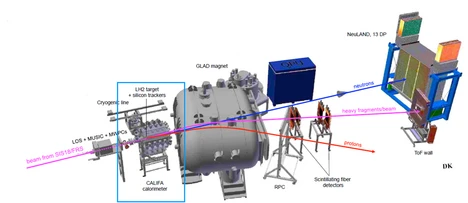A next generation experiment for studies of Reactions with Relativistic Radioactive Beams (R3B)
The R3B experiment is part of the NUSTAR Collaboration at FAIR.
R3B will cover experimental reaction studies with exotic nuclei far off stability, thus enabling a broad physics program with rare-isotope beams with emphasis on nuclear structure and dynamics as well as astrophysical aspects.
Detecting complex nuclear reactions in a complete kinematics is very special for this experiment. State of the art detector systems have been developed to precisely record all reaction products ranging from light and heavy fragments to also neutral particles like gamma rays or neutrons with the highest efficiency.
The TUM group has a special focus on the CALIFA detector (CALorimeter for In-Flight detection of gamma-rays and high energy charged pArticles) a complex detector based on scintillation crystals, that surrounds the target of the R3B experiment. CALIFA will act as a total absorption gamma-calorimeter and spectrometer, as well as identifier of charged particles from target residues.
Currently we are preparinging on a new series of experiments constraining the neutron matter equation of state (EOS) by precise measurement of neutron-skin thicknesses in the most neutron rich nuclei.
The EoS for asymmetric nuclear matter is a relation between the energy per nucleon E, the nucleon density ρ, and the asymmetry parameter δ. The symmetry energy term S(ρ) of the EoS is the most uncertain one and especially at high nuclear matter densities rather poorly constraint experimentally. However, since properties of asymmetric nuclei are determined by the symmetry energy and its derivative around ρ0, experiments with radioactive beams provides a promising opportunity for precise constraints on the neutron pressure with least model dependencies.
For more information, contact Dr. Roman Gernhäuser.
